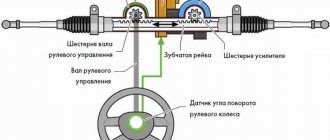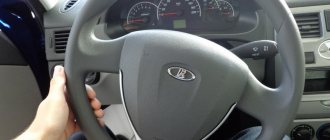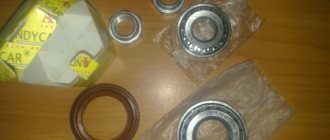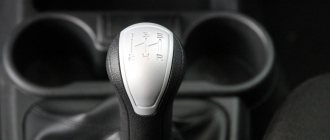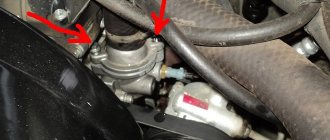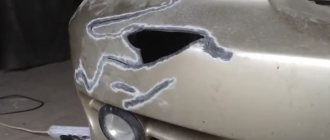2.1. The total play in the steering exceeds the following values:
- Passenger cars and trucks and buses based on them - 10°
- Buses - 20°
- Trucks - 25°
2.2. There are movements of parts and assemblies not provided for by the design. Threaded connections are not tightened or secured in the correct manner. The steering column position locking device is inoperative.
2.3. The power steering or steering damper provided by the design is faulty or missing (for motorcycles).
What is meant by total steering wheel play?
Another term that requires consideration is “total backlash.” It refers to the total angle, which starts from the extreme position of the steering wheel on one side when turning begins, to the opposite position when the car starts moving in the other direction.
To understand the principles of operation of the total backlash, it is important to understand the design and operating features of the control system. Based on the technical component, the operating principle of the backlash is as follows.
There is a rod in the transmission of steering rods, which is fixed with a small gap of one or two millimeters.
This distance is necessary to protect the steering system linkages from wear due to excessive friction.
The presence of a gap is a technological solution that allows you to keep the hook in the required position and not touch the surface of the teeth.
For the driver, this parameter represents free movement of the steering wheel, which allows for more precise control of the car and to feel at what moment the direction of movement of the vehicle changes.
Essentially, this is the total distance the steering wheel travels before the car moves to the left or right.
Many people mistakenly consider this phenomenon negative and try to get rid of it. You shouldn’t do this, because play in the steering is the norm for every car. Another thing is that it must have a strictly defined value.
An interesting pattern can be traced here - the larger the car’s dimensions, the higher the backlash indicator.
In the process of measuring the total backlash, a number of conditions must be met:
- The front wheels are located in a neutral position and stand on a hard (asphalt or concrete) surface.
- The steering wheel tires are dry and clean.
- The car engine is started. This is relevant if the operation of the power steering is tested.
- The tension of the power steering pump drive belt, as well as the level of the working fluid, must meet the requirements approved by the manufacturer.
The total play is checked by measuring the angle of rotation of the control wheel between the fixed positions for changing movement to the left and right.
To obtain accurate parameters, measurements are made two or more times.
Checking the steering wheel play.
The steering wheel or steering wheel is probably one of the most important parts of steering.
It's no secret that a working steering wheel is the safety of the driver, passengers and other road users. When there is play in the steering wheel, car control deteriorates and the car later reacts to the driver’s actions. It is safe to say that increased play indicates a malfunction of some parts of the steering mechanism. We will tell you further about how to check the play in the steering wheel. Place the car on a level and preferably non-slippery surface. To get started, prepare a ruler; you can use a long strip with marked divisions as it. For a ruler, 130cm will be long enough. You will also need wire for marking. For wire, use soft, non-steel wire. The maximum permissible play of the steering wheel should not exceed 5 degrees, taking into account the 360 degree measurement.
The front wheels should be installed straight ahead of the vehicle.
We would like to draw your attention to one significant point: if the wheels are straight, but the steering wheel spokes have not taken a horizontal position, this indicates that the wheel alignment angles may be incorrect, or there are faults in the suspension or steering.
The image shows how to install the ruler, preferably so that the middle touches the headlight switch lever; the lever itself should be moved to the low beam position. In this case, the outer part of the ruler should lie on the rim of the steering wheel. Next, we will check the free play of the steering wheel. Turn the steering wheel clockwise until the wheels begin to turn, but do not change the position of the ruler. Wrap the wire around the steering wheel to prevent shifting and tighten with pliers. The location is approximately shown in the image. Next, without changing the position of the ruler, turn the steering wheel counterclockwise until the wheels begin to turn, secure the wire. Using a caliper, measure the distance, it should be equal to the values given below. If the outer diameter of the steering wheel is 40 cm, then the play should not exceed 17 mm.
If the backlash exceeds these figures, then it may be possible to eliminate it by adjusting the engagement of the roller with the worm.
If the backlash cannot be eliminated, then you should go further along the chain until the causes of the malfunction are determined.
Permissible backlash in cars
The traffic regulations stipulate normalized indicators of total play for various cars. In addition, this parameter should not exceed the figures specified in the documentation for the operation of the machine.
If there are no special recommendations in the manufacturer’s papers, the backlash should be as follows:
- For passenger cars, as well as bus and truck components made on their basis - 10;
- For buses - 20;
- For trucks -25.
- For VAZ-2106, 2107, 2110, 21213 - 5;
- For Gazelle 3302 - 20 (passenger version) and 25 (truck).
Reasons for large backlash
The increase in play can be explained by changes in the design features of the steering, as well as the destruction of their elements.
The main reasons include:
Generally speaking, play occurs when there is a fault in the chain between the steering wheel and the wheels.
To find out the reason, you need to go through the entire chain and identify the “weak” points. The main thing is to make sure that we are talking about increased free play, and not about other problems.
Other causes of play in the steering include:
- Wear or incorrect adjustment of the engagement of the “worm” and the roller mechanism.
- Worn swing arm axle or bushings.
- Loose crankcase fasteners.
Signs of breakdown
As noted above, in order to effectively eliminate a malfunction, it must be diagnosed in a timely manner. To do this, it is enough to know the signs of play in the steering.
The main symptoms include:
- The appearance of a knock in the steering mechanism;
- Increased vibrations while driving;
- Creaking when turning wheels;
- Deviation from a given trajectory when the steering wheel is in a straight position.
When adjusting the steering play, you should take into account the manufacturer’s recommendations and traffic rules.
The configured parameter should not exceed the upper limit, but you should not underestimate the indicator either.
Too little steering wheel play can lead to additional discomfort and poor vehicle controllability.
At the same time, you should not ignore the appearance of a small backlash, because over time this parameter may increase, and then it will be more difficult to deal with the problem.
And it’s inconvenient to drive a car when you constantly have to “catch the road” and turn the steering wheel in one direction or the other.
Steering play - possible causes and solutions
Steering wheel play is a common problem among car owners. This defect affects not only a comfortable, but also a safe ride. A faulty steering wheel can lead to situations where it is impossible to perform a maneuver quickly. If the defect is not corrected, it can lead to many consequences.
Let's look at what could be the causes of steering play and how to fix this problem.
Why does backlash occur? When a car is used for a long time, the following elements gradually become faulty:
- traction;
- bearing;
- bipod shaft;
- bushings;
- roller surface.
After a certain period of time, the gap in the steering wheel begins to widen. This leads to various noises and vibrations. In addition, the car begins to behave unstably while driving. If you drive at high speed with a broken steering wheel, you can become involved in a serious accident.
Causes of wear . In each individual case of steering play, a thorough diagnosis must be carried out. But, in most cases, it wears out quickly for the following reasons:
- Bad roads. If the car is driven on bad roads with potholes and bumps, the steering mechanism is more susceptible to failure. All mechanical influences affect, first of all, the wheels and, accordingly, the steering wheel.
- Bad tires. Due to low-quality rubber, the service life of many parts is significantly reduced, including suspension, hinges and steering rods. If the rubber has poor shock-absorbing properties, the steering mechanism will not last long.
- Fastenings. A very common problem that can be solved in a matter of minutes. The nuts on the steering wheel mount sometimes become loose.
How to eliminate play in the steering wheel . Let's look at how you can eliminate excess play in the steering wheel. If the cause of the breakdown is poor fastening, you must do the following:
- remove the decorative panel from the steering wheel;
- tighten the nut using a socket wrench.
Another reason for failure is wear of the rod. During operation, the gaps in the units expand and this leads to an increase in backlash. You can fix the problem like this:
- remove the fastening nut and unfasten the assembly;
- remove the hinges and insert new parts;
- install the rods and screw them into place.
Another common cause is poor fastening of the adjusting rods, which are designed to adjust wheel toe. Adjusting the toe angle could cause the rod to jump out. To fix this problem, you need to re-attach the unit according to the instructions for the car.
Bottom line . A properly functioning steering mechanism, as well as a braking system, ensures safety while driving. Therefore, any malfunction or problem related to the steering wheel must be addressed immediately.
- Camp Jeep: when the coolest off-road vehicles gather in one place
See all photo news >>
Diagnosis of the problem and instruments used
To determine whether the parameter corresponds to the norm, you need to do a small check.
To make sure there is a problem, you can use a special device - a backlash meter.
With its help you can check the total (total) play in the system.
One of the device options is K 524 M or ISL-M, which can be used by ordinary car owners and professionals at service stations.
Using a backlash meter, it is possible to determine the amount of free play in just three minutes, including taking into account installation and removal of the device.
The algorithm for diagnosing steering play is as follows:
- Start the engine (it should be idling);
- Place the front wheels parallel to the longitudinal axis of the machine. At the same time, make sure that the hydraulic booster is working;
- Turn the steering wheel one way and then the other. At this moment, record the moments when the front wheels begin to scroll in the required direction. The distance that the steering wheel travels between these intervals is called play (free play).
This check is considered an excellent option for drivers who need accurate and quick information.
It does not matter how the problem was diagnosed. If the steering play exceeds the norm, it must be eliminated.
Often the driver is faced with such a malfunction as steering play. This problem can lead to serious problems, so it is important to detect and fix the problem in time.
Contents of the article: The steering is one of the most important for driving, and failure in the form of play is not one of the pleasant situations. Often the reason for the appearance can be various reasons, such as poor running gear, wear and tear of parts, and, most often, the condition of our roads. Therefore, we will consider how to identify play in the steering and how to carry out repairs.
Signs
If the car’s chassis becomes less and less sensitive to your influences, then it’s time to analyze the problems that have arisen in the control. The maximum permissible free play of the steering wheel is 30 millimeters, or 10 degrees, according to traffic regulations. Any deviations from the norm are considered malfunctions.
In order to determine whether the backlash fits within this parameter, you need to do a small check:
- First, set the engine to idle and set the front wheels in such a position that they are parallel to the longitudinal axis of the car. The hydraulic booster must also work at the same time.
- Then you need to slightly turn the steering wheel in different directions and record the moment when the front tires begin to move. The entire distance that the steering wheel travels “to” is free play, that is, backlash.
- For an accurate check, you can get hold of a play meter - this is a special device that is used to control the total play in the steering of a car. For example, the mechanical model of the play meter K 524 M can be used both in a home garage and in professional auto repair shops. The 524 playmeter will help you determine free play in just three minutes - including installation and removal of the device. This check is the simplest and most convenient option.
Although in fact it doesn’t matter what exactly helped you diagnose the problem - the 524 play meter, some other model of this device, or simple measuring tools. If the problem is identified, you need to fix it.
The concept and causes of play in the steering mechanism
The steering design itself is not complicated.
It contains a special rod that does not fit tightly to the car parts. It must have a small gap so that the parts do not wear out in case of friction. However, if the total play reaches fairly large levels, this can cause serious malfunctions, which can lead to accidents on the road. A backlash of 10° is considered an acceptable norm. It is important to remember that a small play can develop into a large one, and therefore you should carefully consider this issue if there are clear signs of problems with the steering. These signs may include knocking, squeaking, vibration, or the need to turn the steering wheel hard to the left or right, even on a flat road. In this case, the steering wheel stops “obeying” the driver or performs actions somewhat late.
There are several reasons for the appearance of play and they all lie in the steering design itself. One of the first reasons may be that the tip or bearing has failed due to wear.
The second reason may be a recent car repair, namely the fact that sometimes the central hub nut is not sufficiently secured. This is where the backlash comes from. Also, free movement of the steering wheel may indicate that the hydraulic oil is becoming unusable and needs to be replaced.
In general, in order to discover the true cause of technical problems, the driver must check every detail of the entire steering system, since all parts and mechanisms are interconnected.
Why does backlash occur?
With prolonged, active use of the vehicle, the following control elements wear out:
- roller surface;
- bearing;
- bushings;
- bipod shaft;
- T-slot on the shaft;
- adjusting screw head;
- rubber-metal hinges;
- traction.
Over time, the play in the steering wheel increases, which leads to the appearance of extraneous noise and vibration, and unstable behavior of the car on the road.
Driving at high speed can lead to an emergency situation - poor vehicle control due to faulty suspension elements.
How to determine the appearance of play in the steering
In order to check the car for problems with the steering, namely the presence of play, the following operations must be performed.
First of all, it is necessary to switch the engine to a special operating mode when the vehicle is stationary - idle. After this, you should start turning the steering wheel and monitor the response time of the wheels to these commands. It is this distance that shows the amount of play. Today, for the convenience and accuracy of measuring backlash, there is a special device - a backlash meter. It helps to measure and control the total backlash.
Eliminating play in the steering
First of all, the check should begin with the universal joint and its screws.
Turn the adjusting screw to the required value. Afterwards, check again for the presence and amount of play. If the results are unsatisfactory, do the work again. If this does not help, then the cause of the breakdown lies elsewhere. The next step is to drive the car into the inspection hole. The problem of play may lie in the steering rod joints. Most likely, these parts are worn out and there is a need to replace them or firmly fix them. You should also check the fastening of the steering rods and tighten them if necessary.
However, if this does not eliminate the cause, then most likely you will have to disassemble the entire steering system. It is better to do this at a car service center, as there is a risk of damaging the system.
